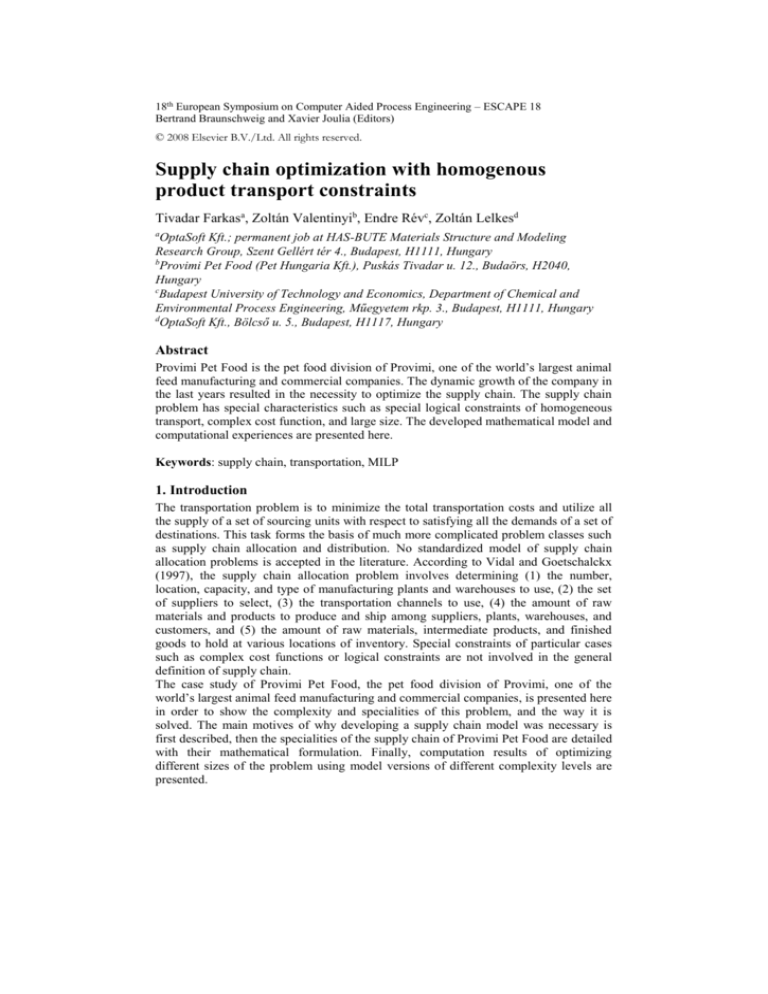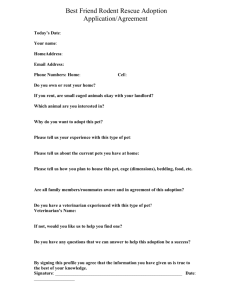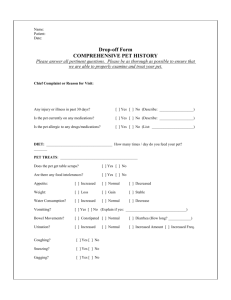
18th European Symposium on Computer Aided Process Engineering – ESCAPE 18
Bertrand Braunschweig and Xavier Joulia (Editors)
© 2008 Elsevier B.V./Ltd. All rights reserved.
Supply chain optimization with homogenous
product transport constraints
Tivadar Farkasa, Zoltán Valentinyib, Endre Révc, Zoltán Lelkesd
a
OptaSoft Kft.; permanent job at HAS-BUTE Materials Structure and Modeling
Research Group, Szent Gellért tér 4., Budapest, H1111, Hungary
b
Provimi Pet Food (Pet Hungaria Kft.), Puskás Tivadar u. 12., Budaörs, H2040,
Hungary
c
Budapest University of Technology and Economics, Department of Chemical and
Environmental Process Engineering, Műegyetem rkp. 3., Budapest, H1111, Hungary
d
OptaSoft Kft., Bölcső u. 5., Budapest, H1117, Hungary
Abstract
Provimi Pet Food is the pet food division of Provimi, one of the world’s largest animal
feed manufacturing and commercial companies. The dynamic growth of the company in
the last years resulted in the necessity to optimize the supply chain. The supply chain
problem has special characteristics such as special logical constraints of homogeneous
transport, complex cost function, and large size. The developed mathematical model and
computational experiences are presented here.
Keywords: supply chain, transportation, MILP
1. Introduction
The transportation problem is to minimize the total transportation costs and utilize all
the supply of a set of sourcing units with respect to satisfying all the demands of a set of
destinations. This task forms the basis of much more complicated problem classes such
as supply chain allocation and distribution. No standardized model of supply chain
allocation problems is accepted in the literature. According to Vidal and Goetschalckx
(1997), the supply chain allocation problem involves determining (1) the number,
location, capacity, and type of manufacturing plants and warehouses to use, (2) the set
of suppliers to select, (3) the transportation channels to use, (4) the amount of raw
materials and products to produce and ship among suppliers, plants, warehouses, and
customers, and (5) the amount of raw materials, intermediate products, and finished
goods to hold at various locations of inventory. Special constraints of particular cases
such as complex cost functions or logical constraints are not involved in the general
definition of supply chain.
The case study of Provimi Pet Food, the pet food division of Provimi, one of the
world’s largest animal feed manufacturing and commercial companies, is presented here
in order to show the complexity and specialities of this problem, and the way it is
solved. The main motives of why developing a supply chain model was necessary is
first described, then the specialities of the supply chain of Provimi Pet Food are detailed
with their mathematical formulation. Finally, computation results of optimizing
different sizes of the problem using model versions of different complexity levels are
presented.
2
T. Farkas et al.
2. Motivation
Provimi is one of the leading animal feed producers and distributors in the world,
dealing with pet food, vitamins, special ready made and semi-finished products. The
company developed its pet food division exponentially in the recent years, is present in
17 countries considering Europe only, has bought 20 other companies between 2002
and 2006, including 12 from Europe. Its shares have been doubled since 2001.
The company intends continuing the expansion both globally and in Europe. The
management is faced to new challenges because of the sudden increase in the number of
European affiliated companies, and particularly the producing plants. The producing
capacities distributed in factories of different pre-history in the countries should be coordinated to minimize the logistic and production costs, and to provide the company and
the plants in time and reliably with the related information. Considering this situation,
the European management decided introducing an optimizing software system to aid the
supply chain. This project including the consultation work and developing the optimizer
software system has taken approximately 5 months.
3. Problem characteristics
As is expected in every particular application, the problem of Provimi Pet Food has
specialities which call for special formulations and solution.
Two main decision levels, the level of plants and the level of customers, are considered
in the Provimi Pet Food supply chain problem. Customers have certain demands for
products which can be produced in the plants. The production process is modeled as
being consisted of two consecutive steps. Semi-products are produced in production
lines. These semi-products are subsequently mixed and packaged in packaging lines.
This packaged product is the final product of the plants, and is transported to the
customers. The semi-products can be transported between plants, i.e. a packaging line
can package semi-products produced in another plant.
The level of suppliers is omitted from the model. The level of warehouses is considered
merely in the transportation costs from plants to customers. If a product has to be stored
in a warehouse during the transportation from a certain plant to a certain customer then
the specific transportation cost of that route is increased with the cost of storage.
Therefore, three levels are considered in the supply chain model of Provimi Pet Food:
(1) production lines of plants, (2) packaging lines of plants, and (3) customers (see
Fig. 1).
The problem has four main special characteristics: (1) Complex cost functions,
(2) Minimum constraints, (3) Homogenous transport constraints, (4) Large size.
Fix cost (cl )
BC 3
BC 2
BC 1
BT 1
BT 2
BT 3
Working hours (t l )
Fig. 1. Supply chain model
Fig. 2. Stepwise constant cost function
Supply chain optimization with homogenous product transport constraints
3.1. Complex cost functions
The target is to minimize the sum of transportation costs, production costs, and
packaging costs. The transportation costs are proportional to the amount of transported
semi-products and products. Production and packaging costs consist of variable cost
proportional to the amount of the products, and fix costs. Fix costs are given by
stepwise constant functions, as is shown in Fig. 2. Intervals over which the fix costs are
defined can be specified according to the working shifts, for example.
3.2. Minimum constraints
'Either / or' minimum constraints are considered at the production lines level, at the
packaging lines level, at the semi-product transport, and at the product transport. In each
case, existence of a minimum constraint means that the quantity of produced /packaged
/ transported semi-product / product either has to reach a defined minimum level or has
to be zero. In each case this minimum constraint expresses the economical consideration
that it is not worth to produce, package, or transport, below a minimum quantity (e.g.
one truck, in the case of transportation).
3.3. Homogenous transport constraints
Homogenous transport means that any amount of a given product is transported to a
customer from a single, not a priori assigned, plant even if that product can be produced
in several plants. Homogenous transport is specified in order to prevent the customer
from receiving a mixture of different quality products that might occur because different
raw materials and processing methods are applied at the different plants.
3.4. Large problem size
The supply chain problem of Provimi Pet Food involves at least eight plants each
containing one to three production and packaging lines, more than 80 customers, and
more than 800 products.
This large size and the above mentioned special constraints result in a very difficult and
complex problem, and it renders developing and applying a well-formulated
mathematical model necessary, as well as special preliminary procedures before
commencing the optimization process.
4. Mathematical model
The supply chain problem of Provimi Pet Food is first formulated as a Generalized
Disjunctive Programming (GDP) model using continuous and logical variables, then it
is transformed into a Mixed Integer Linear Programming (MILP) model using binary
variables instead of the logical ones.
The mathematical models incorporate mass balance equations, capacity constraints, the
cost functions, and the special constraints mentioned in the previous section. The mass
balance equations, the capacity constraints, and the variable cost functions, are all linear
and need not be explained here. How the special constraints are formulated is explained
below.
4.1. Complex cost functions
The fix cost cl of production or packaging line l depends on its working hours tl. The
range of variable tl is subdivided to a number of shifts s. The time moment borders of
these shifts are given by the upper bound BTs of shift s. The constant fix cost of the line
in shift s is given by parameter BCs.
In the GDP representation, logical variables zsl,s are assigned to the shifts. If the value of
the independent variable is in or above shift s then zsl,s=1, else zsl,s=0:
3
4
T. Farkas et al.
zsl ,s
zsl ,0
t
0
BT
t
BT
l
l
,
s
1
l
l
,
s
s1
cl 0
cl BC l ,s
l, s
(1)
(Character denotes the logical operation 'exclusive or' or XOR.) This logical equation
is transformed into algebraic one using the method of Lelkes et al. (2005):
tl ysl ,s DTl ,s
l
(2)
l
(3)
l , s 2
(4)
s
cl ysl ,s DC l ,s
s
ysl ,s ysl ,s 1
where DTl,s is the length of shift s at line l, DCl,s is the fix cost increment of shift s of
line l related to the fix cost of the previous shift s1, and ysl,s is a binary variable.
4.2. Minimum constraints
How these constraints are formulated is exemplified with the minimum product
transport constraint. The qtp,c,pr transported quantity of product pr from plant p to
customer c either has to be equal to zero or not smaller than a minimum transport
quantity QTMINp,c,pr. In the GDP formulation of this constraint, logical variable
ztp,c,pr {true, false} denotes whether there is product transport on the given route:
zt p ,c , pr
zt p ,c , pr
qt
p ,c , pr 0 qt p ,c , pr QTMIN p ,c, pr
p, c, pr
(5)
This logical constraint is transformed into algebraic form using binary variables
ytp,c,pr {0, 1} instead of the logical ztp,c,pr ones:
qt p ,c , pr QTMIN p ,c , pr yt p ,c , pr
p, c, pr
(6)
4.3. Homogenous transport constraints
The homogenous transport of product pr to customer c can be defined as a logical
constraint using logical variable zhp,c,pr. If zhp,c,pr is true, i.e. if product pr is transported
only from plant p to customer c, then the transported quantity qtp,c,pr is equal to the
demand Dc,pr of customer c for product pr, and the transported quantity from all the
other p2≠p plants is zero.
zh p ,c , pr
zh p 2 p ,c , pr
qt p ,c , pr Dc , pr qt p 2 p ,c , pr 0
p, c, pr
(7)
This logical constraint is transformed into algebraic form using the Convex Hull
technique:
Supply chain optimization with homogenous product transport constraints
qt p ,c , pr Dc , pr yh p ,c , pr
yh
p ,c , pr
1
5
p, c, pr
(8)
p, c, pr
(9)
p
where yhp,c,pr is a binary variable.
5. The optimization method
The solution of the problem is implemented in AIMMS modeling language (Bisschop
and Roelofs, 1999) using CPLEX as MILP solver. AIMMS has been chosen by Provimi
Pet Food because of its advanced graphical user interface, and because the most modern
solvers can be attached, and the program can be easily extended and developed in case
of changing requirements.
In order to facilitate the optimization, preliminary procedures are developed which run
before the optimization of the main model. First, the tightest bounds of the variables are
computed using a Linear Programming (LP) model. Then a feasibility check is
performed by solving a simplified LP problem generated from the main MILP model. If
the problem is infeasible then the program provides the user with information about the
possible reasons of infeasibility. If the problem is feasible then initial values are
calculated by solving the relaxed LP model of the main MILP model. As a result of this
initialization, the solution procedure of the main MILP model starts from a near optimal
point, and thus the solution time is decreased. Finally, the main MILP model is solved.
Solving the main MILP model takes no more than 15 seconds on a PC (2.6 MHz CPU,
512 Mb RAM), and solving the whole problem (including the generation of each
mathematical model) takes no more than 5 minutes with relative optimality tolerance
(gap) 10-13.
6. Computation results
The developed MILP model is tested on three example data sets of different sizes. Main
characteristics of the example data are shown in Table 1.
Table 1. Characteristics of the example data sets
Size
Nr. of
prod.
lines
Nr. of
pack.
lines
Nr. of
customers
Nr. of
products
Nr. of
eqs.
Nr. of
vars.
Nr. of
bin.
vars.
Small
3
5
19
201
4928
4659
1800
Medium
6
11
45
299
17365
19728
13608
13
21
83
856
88240
99707
79826
Large
The effect of including the special constraints (complex cost function equations
minimum constraints, homogeneous transport constraints, and) are tested with different
versions of the MILP model. Model 1 contains the material balances, the capacity
constraints, and the cost functions only. Model 2 includes all the constraints of Model 1
and the minimum constraints as well. Model 3 includes all the constraints of Model 1
and the homogenous transport constraints as well. Model 4 contains all the above
6
T. Farkas et al.
mentioned constraints. The solution time data (in CPU sec) at relative optimality
tolerance (gap) 10-13 are collected in Table 2 and visualized in Fig. 3.
Table 2. Computation time of model versions
Size
Model 1
Model 2
Model 3
Model 4
Small
0.02
0.05
0.02
0.07
Medium
0.08
0.20
0.11
0.23
Large
1.06
4.58
1.23
6.47
Extending Model 1 with the minimum constraints (Model 2) increases the solution time
at least with 150%. But including merely the homogenous transport constraints
extension (Model 3) increases the solution time just slightly. Homogenous transport
constraints are stricter constraints than minimum constraints but they probably cause
smaller increase in solution time because (1) this extension means less number of
constraints containing binary variables, and (2) their proper Convex Hull formulation
results in smaller search space during the optimization.
7,00
6,00
CPU sec
5,00
Model 1
4,00
Model 2
3,00
Model 3
Model 4
2,00
1,00
0,00
Small
Medium
Large
Fig. 3. Computational times of model versions
7. Conclusions
An MILP model has been developed for solving the supply chain problem of Provimi
Pet Food. The model includes special logical constraints such as stepwise constant cost
functions of production and packaging lines, minimum constraints for production,
packaging and transportation, and the constraints of homogenous product transport. The
solution procedure is developed in AIMMS modeling language.
References
J. Bisschop, M. Roelofs, 1999, AIMMS The User’s Guide, Paragon Decision Technology B.V.
Z. Lelkes, E. Rev, T. Farkas, Z. Fonyo, T. Kovacs, I. Jones, 2005, Multicommodity transportation
and supply problem with stepwise constant cost function, European Symposium on Computer
Aided Process Engineering 15, Elsevier, 1069-1074.
C.J. Vidal, M. Goetschalckx, 1997, Strategic production-distribution models: A critical review
with emphasis on global supply chain models, Eur. J. Op. Res. 98, 1-18.









